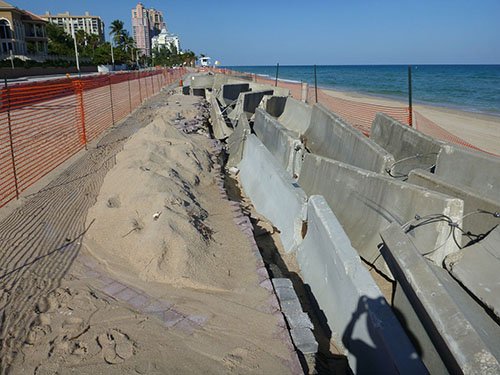The 6-Second Trick For Shore Protect Team
Wiki Article
Little Known Questions About Shore Protect Team.
Table of ContentsSee This Report on Shore Protect TeamThe Greatest Guide To Shore Protect TeamThe Main Principles Of Shore Protect Team What Does Shore Protect Team Mean?Examine This Report about Shore Protect TeamFascination About Shore Protect TeamFascination About Shore Protect Team
Decline in residential property worth: As the area tourism is impacted by erosion, so then is the economic situation. Customers are less most likely to browse for a beach house that can be damaged anytime by the impending flooding and erosion emergency situation. In turn, residential property worth can drop tremendously and affect the whole region.Whether a coastline is just little and crowded or needs to close entirely for the safety and security of the ecological community and neighboring homes, this greatly influences tourism. In turn, neighborhood economic climates are impacted (https://www.band.us/band/100254607). Risk of injury: The increased risk of flooding and structural failures creates an increased threat of injury to close-by travelers and neighborhood members

is home to greater than 84,240 miles of coast with 41% of it exposed to the open sea. Coastal designers supervise of protecting the coastline versus changes by minimizing the harmful influences of both natural and man-made occurrences. Coastline stabilization is straight related to their job. Beachfront hotels: Due to the fact that coastline disintegration effects tourism, it affects the success of beachfront resorts.
The 4-Minute Rule for Shore Protect Team
This ultimately causes closures and deserted beachfront buildings. Coastal commercial organizations: No travelers indicates no service. For those businesses accommodating residents, their residential property goes to threat of damage from erosion and flooding. Coastal state parks: State parks that exist along coastlines are at threat of damages. Not only to the manufactured frameworks and residential properties on site, yet also to the natural ecosystems that exist within.Difficult stablizing utilizes manufactured frameworks as defense to manage erosion. The majority of kinds of hard stablizing like seawalls and sheet steel are not perfect for coastline stabilization.
The 8-Minute Rule for Shore Protect Team
There's also insufficient proof of their effectiveness depending upon the kind of shoreline and neighborhood problems. Tough stablizing methods have a tendency to be more hard to set up and don't match the natural visual, standing out like a sore thumb and hurting regional ecosystems in numerous situations. Coastline sustenance is the procedure of including shed sand and debris back to coastlines after disintegration has happened.TrapBags help in the process of beach nutrition by securing all-natural environments and enabling plants to grow. While this procedure can be pricey and is not irreversible, the pros often tend to outweigh the cons. TrapBag barriers deal numerous homes that make them optimal for seaside and shore disintegration protection. They're: Eco-friendly: You can utilize native soil both to border and to load the TrapBags.

Examine This Report about Shore Protect Team
Easy to install: Alleviate of installation means TrapBags can be deployed quickly in case of an emergency. They can additionally be mounted without any hefty equipment. Inexpensive: TrapBags are suitable for both small and big locations of shoreline. They give an inexpensive option to cover projects of any type of size.The proper seawall design counts on location-specific facets, consisting of surrounding erosion procedures. There are 3 primary sorts of seawalls: upright, rounded, stepped, and piles (see table below). A report published by the United Nations Setting Program (UNEP) recommends that the tsunami of 26 December 2004 created less damages in the areas where natural barriers were existing, such as mangroves, reef or seaside greenery.
All-natural barriers, such as coral reefs and mangrove woodlands, stop the spread of tsunamis and the flow of coastal waters and minimized the flooding and rise of water. A cost-benefit technique is a reliable means to figure out whether a seawall is ideal and whether the benefits deserve the expense.
The 5-Second Trick For Shore Protect Team
A seawall is a static feature which can contrast with the dynamic nature of the coast and hamper the exchange of debris between land and sea. Advantages and downsides of seawalls according to Short (1999) Benefits Disadvantages Long term service in contrast to soft coastline nourishment (https://jet-links.com/Shore-Protect-Team_384695.html).
This can create coastlines to dissipate, rendering them pointless for coastline goers. Usually, seawalls can be an effective way to regulate coastal erosion, yet just if they are constructed well and out of materials that can stand up to the pressure of ongoing wave power.
The Facts About Shore Protect Team Revealed
The appropriate seawall design depends on location-specific elements, including bordering disintegration procedures. There are three major kinds of seawalls: upright, curved, tipped, and mounds (see table below).All-natural obstacles, such as coral reefs and mangrove forests, stop the spread of tidal waves and the flow of coastal waters and alleviated the flood and rise of water. A cost-benefit strategy is an effective way to determine whether a seawall is appropriate and whether the advantages are worth the expenditure.
The Definitive Guide for Shore Protect Team
A seawall is a static function which can clash with the dynamic nature of the coastline and hinder the exchange of sediment in between land and sea. Benefits and downsides of seawalls according to Short (1999) Benefits Downsides Long term service in contrast to soft beach nutrients.
This can create coastlines to dissipate, rendering them ineffective for beach goers. Typically, seawalls can be a successful way to manage coastal erosion, yet just if they are built well and out of materials that can endure the pressure of ongoing wave energy. Some understanding is required of the coastal processes and morphodynamics certain to the seawall place.
Report this wiki page